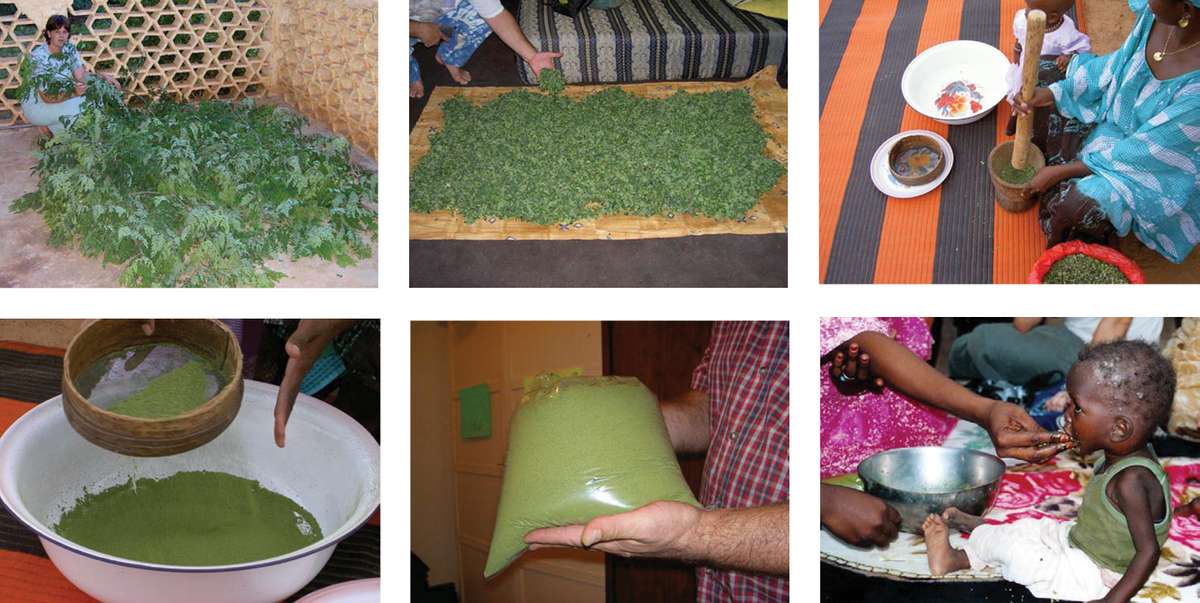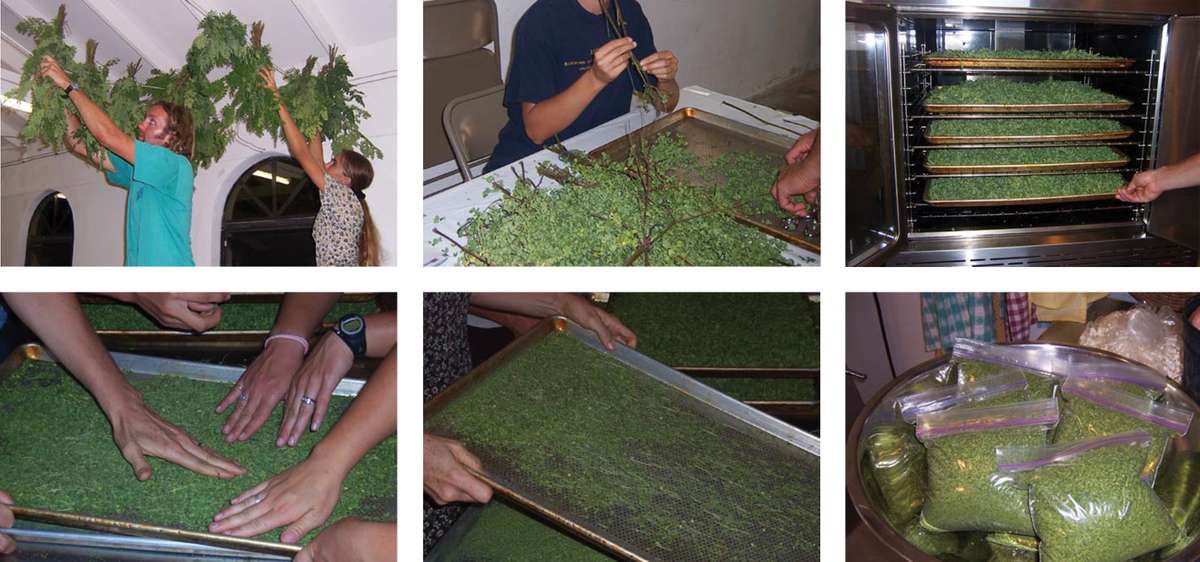
The leaves of the Moringa oleifera tree are very nutritious. They can be consumed fresh, cooked or dried. Since dried Moringa leaves retain their nutrient content, it is possible to convert them into leaf powder. When there is an abundance of leaves, this leaf powder can be made and stored easily. Moringa Leaf Powder is an excellent nutritional supplement and can be added to any dish.
Planting & Growing Moringa oleifera
There are 13 identified species of Moringa. The most popular is Moringa oleifera, a fast-growing tree grown throughout the tropics and sub-tropics. Moringa grows best at temperatures between 25-35°C (77-95°F); it is fairly drought tolerant but grows best with annual rainfall of 250-1500mm (10-60in); it prefers altitudes below 600m (2000ft) but can survive at 1200m (4000ft) in the tropics; it does not tolerate prolonged flooding or poor drainage; Moringa prefers well-drained sandy-loam or loam with a pH of 5.0-9.0; and it can be propagated by seeds or cuttings.
Moringa is a versatile plant that can be grown as a tree or as a “perennial-vegetable” under intensive cultivation. Moringa trees can grow up to 4m (15ft) a year reaching a height of 15m (50ft) and can live for approximately 20 years. Regular pruning or trimming is recommended to encourage branching and leaf production.
Under intensive cultivation, Moringa is direct-seeded or transplanted at close spacings into a fertile garden bed and then regularly trimmed. This intensive method produces the maximum quantity of leaves possible in a small plot. Studies in Nicaragua determined that optimum spacing for maximum production in intensive plots was 10cm x 10cm (4in x 4in). Disadvantages of this method are that it does not allow for seed production and it requires increased maintenance for irrigation, fertilization, and pest control.
Making Moringa Leaf Powder
Leaf Harvest
Moringa leaves can be harvested at any time once trees are established. For leaf harvest in intensive production plots, plants are trimmed to 15-50cm (6-20in) above the ground. Intensive plots can be trimmed up to 9 times per year. For leaf harvest in trees, cut the entire tree back to a height of 1-2m (3-6ft); this is best done during the rainy season so that the tree is able to recover before the dry season. Other methods of leaf harvest for trees include: trimming selected branches (leaving some branches for the next harvest or seed production); trimming each branch back by half; and picking a few leaves off of each branch.
Once leaves are harvested, they should be stripped off the stems. During this procedure any damaged or discolored leaves can be set aside for animal feed or compost. [Stems and branches can also be used as animal feed or in compost.] Leaves are then rinsed in clean water or a very weak bleach solution (1:100) to remove dirt and germs.
Drying Leaves
Leaves should be dried in an area protected from light to prevent the loss of vitamins and protected from dust and pests to prevent contamination. If necessary, leaves can be covered by thin cloth or mosquito netting to help keep them clean while drying. The drying process should be completed as quickly as possible to prevent the growth of molds; if leaves mold or mildew they should be thrown out or used for compost. If the humidity of the air is high, leaves should be spread out in a thin layer and mixed frequently; dehydrators, ovens, driers or fans may be required in cases of extreme humidity. When leaves become brittle and crush easily, they are dry.
Drying suggestions:
- spread cleaned leaves on a cloth inside the house or other protected structure
- spread cleaned leaves in hanging trays made with mosquito netting
- hang leaf bunches from roof or porch with string (similar to tobacco drying; for this method, the leaves are left on the stems)
Grinding Leaves
Dried leaves can be made into powder using a mortar & pestle, local grain grinders, burr mills (hand crank or motor driven), or simply by rubbing the dried leaves against a fine screen. Once the dried leaves have been transformed into a powder, the powder is sifted to remove any remaining stems.
Storing Moringa Leaf Powder
Moringa Leaf Powder should be stored in air-tight containers protected from heat, humidity and light. If the powder is not adequately dried or stored it could encourage the growth of molds or mildews which could cause problems ranging from unpleasant to harmful. If stored powder is exposed to heat or light it will degrade and the nutrient content will be reduced. Moringa Leaf Powder can be stored for up to 6 months under the following conditions: clean, dried powder stored in air-tight containers, protected from light and humidity, and kept below 24°C (75 °F).
Moringa Leaf Processing Example: Bahamas
This area has a humid climate. The branches were hung in bunches for 24 hours to make it easier to strip the leaves from the stems. Then a low-temperature oven was used to dry the leaves (the pilot light of a gas oven was used). The dried leaves were then crushed into flakes by pressing through a metal tray with small holes.
Moringa Leaf Processing Example: West Africa
This area has a very dry climate. The leaves shown in the first photo were dried indoors, crushed with a local mortar and pestle, sifted using a local screen sifter, and produced the 7.5kg (16.5lb) bag of leaf powder shown below.

Using Moringa Leaf Powder
Moringa Leaf Powder can be added to any food or beverage and it will increase the vitamin, mineral and protein content. For healthy individuals, a few spoonfuls of Moringa Leaf Powder can be added to any meal to make it more nutritious. Since the nutrient content of Moringa Leaf Powder decreases if exposed to heat, add the powder after the food or drink has been prepared, just before serving.
Moringa Leaf Powder has the greatest impact on those who are more vulnerable: malnourished children, pregnant or lactating women, children at weaning age, HIV/AIDS patients, and the elderly. Malnourished children ages 1-3 years should consume three rounded tablespoons (25g) of Moringa Leaf Powder each day. Pregnant or lactating women should consume six rounded tablespoons (50g) of Moringa Leaf Powder each day. According to FAO/WHO standards, these amounts provide the following in terms of RDA3 :
| Nutrient | %RDA in 25g powder for children | %RDA in 50g powder for pregnant women |
|---|---|---|
| Protein | 42% | 21% |
| Calcium | 125% | 84% |
| Magnesium | 61% | 54% |
| Potassium | 41% | 22% |
| Iron | 71% | 94% |
| Vitamin A | 310% | 162% |
| Vitamin C | 22% | 9% |
Websites
Moringa
- http://www.moringanews.org/ (site en français et anglais)
- https://treesforlife.org/our-work/our-initiatives/moringa (ce site en anglais seulement contient un document pdf sur le moringa en français)
- http://edn.link/xngqft (document en anglais seulement)
Solar Dehydrator
- http://edn.link/wyxnde (document en anglais seulement)
- http://www.i4at.org/surv/soldehyd.htm (plans de déshydrateur solaire avec explications en anglais)
Notes
- Palada, M.C. and L.C. Chang. 2003. Suggested Cultural Practices for Moringa. AVRDC.
- Foidl, N, et al. 2001. The Potential of Moringa oleifera for agricultural and industrial uses.
- Fuglie, L. 2001. The Miracle Tree. Church World Service. p.114.
Cite this article as:
Doerr, B. and L. Cameron 2005. Moringa Leaf Powder. ECHO Technical Note no. 51.
